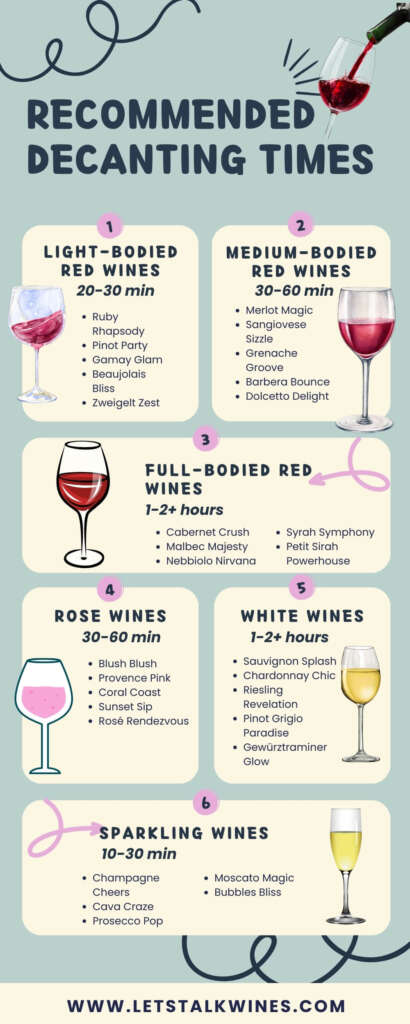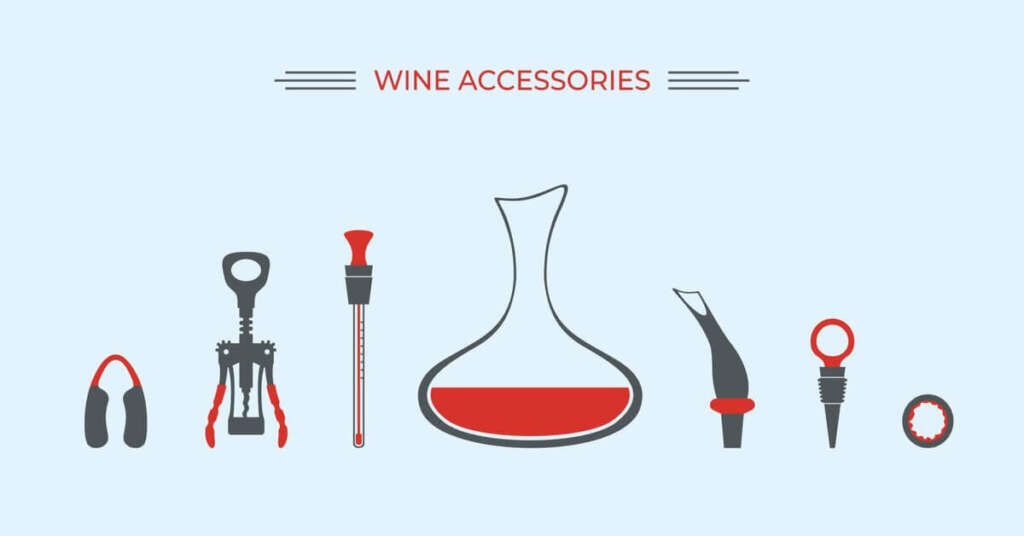So you just pulled a prized vintage from your cellar or snagged an expensive bottle at the store for tonight’s dinner party. Now you’re staring down that iconic vessel wondering: should I bother decanting this wine? Dose Decant Wine even if necessary?
Think of decanting as giving your wine a spa day. It removes unwanted sediment found in aged reds and gently introduces oxygen to young wines, enhancing flavors and aromas. So, what happens? Decanting wine removes sediment, “wakes up” young wines with air, and unlocks richer, more complex flavors.
Decanting isn’t magic, but it can elevate your wine experience. Ready to see (and taste) the difference? Let’s get decanting!
Does decanting wine really make a difference?
I used to wonder that myself standing over bottles of complex Bordeaux, hearty Barolo or heavily tannic Cabernet thinking surely a few minutes of air won’t change much. Oh how wrong I was!
As it turns out, decanting unleashes some fascinating reactions that dramatically improve red wine’s flavor and aroma. Sometimes with literally minutes in the decanter, other times requiring hours of gradual exposure to oxygen to realize the benefits.
Curious what magic happens in that vessel? Read on as I break it all down. We’ll progress from the basics of how to decant, what physically occurs as wine interacts with air, plus why it heightens enjoyment of certain styles. With plenty of tips for maximizing those mouthwatering benefits.
What is Wine Decanting?
Decanting signifies the process of carefully pouring wine from its original bottle into a special container called a decanter. Shaped from clear crystal or glass, a decanter provides added surface area, allowing more wine to interface with oxygen.
This increased aeration alters the wine’s characteristics in various ways as discussed below. Sometimes mellowing out harsh compounds while accentuating appealing aromas and textures instead.
People often confuse decanting with simply allowing wine to breathe. While similar in concept, true decanting accelerates oxygen’s effects thanks to the greater exposed surface area.
So think of it as turbocharging your wine’s evolution compared to casually aerating wine in the glass or via some makeshift funnel contraption.
A wine funnel aims to limit sediment entering your glass. Decanting engages far more dynamic chemical reactions.
But why fuss with all this in the first place? That brings us to…
The Reasons and Benefits of Why Do You Decant Wine!
Primary Goals of Why Decant Wine is important :
- Soften astringent tannins – That dry, grippy sensation.
- Allow aromas to fully express – Bringing out complex layers over time.
- Help clarify cloudy wine – Brighten the appearance.
- Separate old wine from sediment – Leaving it safely behind.
As oxygen permeates the wine, chemical reactions unfurl that transform taste, aroma and mouthfeel – mostly for the better!
Certain styles and conditions especially stand to gain from aeration’s magic touch:
Bold young reds laden with harsh tannins soften wonderfully; mature wines awaken more developed fragrances obscured by age; chilled wine warms up, activating its aromatic compounds.
I’ve seen expensive collectors’ wines bloom stunningly through decanting too. So while not all wines require it, you just may enhance gratification of that special bottle.
But how exactly does all this magic chemistry work? Read on!
The Chemical Reactions Behind Decanting’s Magic
Here’s the science-y part. Four key processes interplay as oxygen permeates decanted wine over time:
1. Softening Tannins
Ever taste a young Cabernet or Nebbiolo and instantly pucker from fierce astringency? That sensation comes courtesy of tannins – polyphenols naturally occurring in grape skins and seeds.
While vital for structure and aging ability, abundant tannins initially taste quite bitter, drying and harsh. Proper contact with oxygen chemically alters tannin molecules via oxidation and polymerization reactions. This makes them taste smoother and more rounded on your palate.
Think of swelling, jagged particles breaking apart and connecting in slippery chains instead…Ahhh, that’s better!
The burlier the wine (i.e Barolos), the longer oxygen exposure it needs to tame tannic intensity. An hour or more may be required.
2. Unlocking Aromas
Innumerable aromatic compounds generate a wine’s bouquet – from fruity esters to spicy phenols and beyond. But many remain bound up or suppressed initially.
Decanting volatizes and oxidizes key aroma compounds like catechins, pyrazines and more. Time swirls with oxygen untangle their molecular bonds, unleashing those pure, lively fragrances.
Young wines still nestle shy, elementary aromas that emerge with coaxing. While older wines often arrive muted until you rouse those bouquet memories. Give it time!
3. Brightening Appearance
Cloudy wines turn clear through decanting, as exposure helps large particles cling together then settle out. Protein chains and heaviest tannins descend first, leaving polished translucency behind. Any remaining floaters missed won’t drastically impede enjoyment.
As lighter pigments combine too, white wines gain more vibrant color. While oxygen lends aged reds renewed ruby tones – further brightening them. Subtly influencing sight before you even sip!
4. Separating Sediment
Leaving crusty bottle deposits behind ranks among the original reasons wine got decanted centuries ago. Particularly back when glass and winery standards were less refined.
As wine meets air, precipitation quickens, rushing those crusty tannins and tartrates to gather. So ideally you catch older wine right before much falls spontaneously. Then pouring it off excludes further unwanted debris.
More modern wines undergo meticulous clarify during production. So unless bottles very old, I wouldn’t decant solely to avoid sediment. It hardly detracts anyway!
In summary, key mechanisms like oxidizing/polymerizing tannins, unlocking aromatics, brightening color and excluding sediment all enable decanting to elevate wine’s sensory experience.
How Long Should You Decant Wine For?
I know you’re thinking “These reactions sound awesome Andrew! But how long to decant wine so that I actually decant to them properly?”
The answer depends…
Too briefly and you miss out; too long and you overdo it. General guidelines for positive effect span:
Young red wines = 30-90 minutes
Mature red wines = 2-4+ hours
However – as with pairing wine and food – too many variables prevent hard-set rules. Beyond personal taste preferences:
- Bottle age
- Varietal (determined tannins)
- Quality tier
- Serving temperature
- Glass shape
- And more…
They all impact exposure time needed. So how best to gauge sweet spot duration?
Taste as you go! Sample initially, then every so often to assess evolution until hitting that moment of zen enjoyment. remain zen.
Certain visual cues help too. Looking for brightening factors mentioned earlier plus how wine moves down glass:
The WONDER Signs Your Wine is Ready:
- Brighter color
- Runs smooth, not sticky
- Opens aromatics
- No bitterness
- Losing edge/grip
- Even integration
And if you do overshoot ideal window, little harm done. Most wines hold up alright. Except perhaps those radiant fruit-forward qualities falling off in genereous crusts.
As tempting as it seems, don’t fall down research rabbit holes seeking precise times. Too many variables are at play!
Recommended Decanting Times by Wine Type
Light-Bodied Red Wines : Examples: Pinot Noir, Gamay, Zweigelt, Schiava
20–30 minutes
Medium-Bodied Red Wines : Examples: Cabernet Franc, Grenache, Merlot, Malbec, Barbera, Dolcetto, Tempranillo
30-60 minutes
Full-Bodied Red Wines : Examples: Cabernet Sauvignon, Nebbiolo, Petit Sirah, Monastrell (Mourvèdre), Tannat
Rosé : Time: Typically none needed, but aged rosés may benefit from brief 30-60 min decanting
White Wines : Time: Typically none needed, but oaked/aged Chardonnay could use 15-30 min to up to 1-2 hrs
Sparkling Wines : Time: None needed for fresh, but vintage/aged sparkling up to 10-30 min
Dessert Wines : Time: Typically none needed, but some aged Sauternes or Tokaji Aszú could use 60+ min

How to Decant Wine Like a Pro
Alright, got the “why” and “how long” parts down. Now, let’s cover the actual process to properly open and aerate wines.
I’ll equip you with pro tips to channel your inner sommelier-level decanting skills in no time!
Choose Your Vessel Wisely
While called a decanter, in truth any aerating vessel will do. But functionality, visual appeal and ease of use matter too.
Lead crystal – Elegant and ornate but affords little oxygenation for cost
Hand-blown glass – Light, beautifully clear to showcase wine
Wide bottomed carafes – Maximizes exposed surface area
Funnels & strainers – More for catching sediment than decanting
Ideally, your vessel…
- Gets used often enough to warrant purchase!
- Pleases visually to elevate occasions
- Aerates wine effectively as needed
- Sits stable on the table/surface
- Pours cleanly without glugging/spurting
Consider scale too. Larger decanters allow starting wines hours before serving. While compact ones suit spontaneous single glass pours.
And backups come in handy for decanting multiple wines simultaneously so choose wisely!
Assemble Proper Accessories

Beyond just a vessel, a few handy wine tools assist the smooth decant:
Corkscrew – Goes without saying! You’ll need this to access the bottle first. I prefer double lever “waiter’s” style corkscrews for their dual power + convenience removing longer corks.
Candle or flashlight – Helps illuminate the neck of the bottle and determine sediment levels/clarity before starting.
Funnel & strainer (optional) – Come in handy catching stray floaters when concerned about very old/fragile wines.
Decanting cradle (optional) – Neat gadget propping bottles at an angle tilted just enough for controlled, drip-free pouring.
Cotton napkins or linen – Keep nearby both the bottle and decanter to catch spills, drips, splatter etc. Wine stains badly so come prepared!
Dump bucket (optional) – For catching the wine you taste-test during decanting but don’t drink.
Glasses – Goes without saying too. But be sure to have enough ready for sampling decanted wine as it evolves.
How to Decant Wine Without a Decanter!
The Big Pour: Simply pour the wine slowly into a large pitcher or wide-mouthed glass. The increased surface area allows some aeration.
Double Duty: Pour back and forth between two carafes or pitchers. This further exposes the wine to air.
The Swirl & Settle: Fill a large wine glass, swirl gently, then let it sit for 30 minutes. Repeat the swirl occasionally for extra aeration.
Funnel Time: Use a clean funnel to transfer the wine from the bottle to a carafe, leaving sediment behind.
Pick the Right Wine
Truthfully most wines can get decanted with pleasing effects if done well. But for best ROI of your efforts, target:
Full-bodied reds
Especially varieties known for:
Abundant tannins – Cabernet Sauvignon, Nebbiolo, Syrah, Sangiovese
Aromatic complexity – Pinot Noir, Châteauneuf-du-Pape, field blends
Age development – Bordeaux blends, Brunello di Montalcino
Cooler temp serving
Such as wine pulled:
- Straight from the cellar
- From the fridge
- That should be chilled in general
Cloudy/Hazy wines
That may benefit from some air exposure to precipitate particles like:
- Unfiltered, natural wines
- Experimentally macerated orange wines
- Older vintages with sediment
Additionally consider wine cost and quality. Is it rare enough to warrant decanting pampering? Will it actually evolve to another level like cru class Burgundy? Or is it best expressive fresh from corking like many fruity young wines?
Dial your efforts to wine character.
Assess Sediment Before Decanting
I already touched on this earlier but checking wine clarity and sediment deserves revisiting.
Remember decanting began historically as a means of separating wine from years of residue. So take a peek beforehand by angling a flashlight up along the bottle’s interior edges and neck.
Crystalline clarity? – Likely younger wine needing air not filtration.
Hazy or murky? – Will benefit from some oxygen exposure bringing brightness.
Heavily clouded? – Give time to separate solids, not just aerate.
Thick dark ring at bottom? – Pour carefully to exclude most of that.
Wispy light particles? – They won’t negatively impact much.
Use best judgment on how to handle. Dealing with mold, extreme cloudiness or profuse flakes? Probably best to avoid decanting this one altogether.
Extract the Cork Cleanly
Insert your corkscrew slowly at a very slight angle, twisting firmly as you penetrate deeper into the cork. Leverage the corkscrew arms fully when ready to smoothly extract the entire cork in one solid motion.
Avoid crumbling the cork if able – little cork bits dropping in spoil first tastes. But if a brittle cork does crack apart, simply strain pouring the wine.
Also note cork condition too – signs of seepage, wetness at bottom or growths indicate possible wine flaws.
Pour Slowly & Steadily at First
With cork removed, begin angling the bottle to pour wine gently into your decanter.
- Choose a cleared space on your countertop or table allowing ample room for both bottle and decanter.
- Over hard surfaces, I recommend placing napkins or towels in case of spills or drips.
- Tilt the bottle gradually, starting wine flow slowly. Too abrupt of an angle causes glugging.
- Ideally keep neck near lip of decanter at all times for a smooth stream rather than big splashes.
- Pour down interior edges of the vessel first to reduce foaming. Splashing heightens bubble formation.
- Fill decanter only about halfway initially. As you taste, judge if you want space for more aeration or not.
Take it nice and easy…no need to rush this relaxing process!
Allow Wine to Settle Before Serving
Once transferred over to the decanter, allow wine a few moments to regain composure. First rapid splashings whip up turbulence and bubbles.
As they dissipate, begin observing wine’s evolving state:
- How brightly clarified does it appear now?
- Are further dregs dropping out noticeably?
- Does pouring comport seem thicker now they’ve settled?
This settling also allows you first insights on evolving aroma and color changes afoot early into the decanting process. Pretty exciting stuff!
Taste Along the Way
Now comes the best part – sampling how time and oxygen mingle are affecting the wine in your decanter!
Be sure to have clean glasses handy to periodically taste-test. Sample soon after first pouring/settling to gauge initial youth or aging status out of bottle.
Then continue checking every 30-60 minutes typically to determine ideal enjoyable point. Remember the “WONDER” visual cues and taste markers signaling sweet spot for drinking.
Don’t Overdo Total Exposure
Judging ideal aeration timeframe can prove tricky. How much too little is obviously no change at all for your efforts. And it’s hard to truly over-breathe wines.
But beyond peak openness, some can start deteriorating:
- Very old wines losing vibrancy
- Fruit-forward reds fading out
- Delicate aromas blowing off
So once at its great crescendo – for your palate – stop excessive exposure. Drink and enjoy that suave bouquest and softened tannins!
Patience while aerating allows wine unfold its splendor. Yet don’t push beyond perfection. Know when to start indulging each decanted wine’s finery at its freshest!
Serving Decanted Wine Properly
You went through all that effort getting the wine aired out beautifully. Now, time to showcase it properly to guests on the table!
Decanting Dos & Don’ts
DO let wine rest again after pouring servings – more jostling stirs up bubbles and particles.
DO keep your decanter out on table for visual appeal along with easy topping off glasses.
DON’T feel compelled to finish the entire bottle just because it is decanted. Use stoppers and store dark/cool later after sampling sufficiency. Corks don’t reseal a vacuum.
DON’T discard the original bottle yet either. Once sediment shook back up, you can use the bottle to store again keeping label info handy should guests inquire specifics on the wine itself.
DO rinse your decanter out promptly after use and let air dry. Sweet-smelling drying racks keep vessels ready to go for next occasion.
DON’T anguish over minor stains or film inside decanters. As long as kept clean smelling, they pose no detriment to future wine quality. Use rice grains + water to help scrub if so compelled by cosmetics.
Make a habit of these best practices and your decanter will deliver many more stellar wine experiences for years of dinner parties to come!
Frequently Asked Questions About Decanting Wine
I’ll finish off digging into wine decanting basics by answering some common questions wine lovers have on the process:
What is the purpose of decanting wine?
The purpose is to expose wine to oxygen allowing advantageous chemical reactions to occur. Decanting softens harsh tannins, unlocks aromas obscured by aging, clarifies cloudiness, and separates old sediment.
What is a wine decanter?
A wine decanter is a specialized glass vessel used to gently pour wine from its original bottle into in order to aerate it prior to drinking. Decanters have a wide bottom and opening to allow substantial oxygen contact triggering chemical changes.
What wines should be decanted?
Full-bodied, tannic reds like Cabernet, Nebbiolo and Bordeaux blends gain greatly from decanting as do aged wines 10+ years old. Chilled/cooler wines warrant decanting too for temperature conditioning. Carefully decant older wines at risk of throwing sediment too.
What are the 3 reasons for decanting wines?
The top reasons are: 1) Softening tannins 2) Unlocking aromas 3) Separating sediment
Extended exposure to oxygen by decanting transforms tannins and helps release obscured fragrance notes.
Which wines do not need decanting?
Wines with low tannins/acidity like Pinot Noir or Gamay rarely require decanting. Most white wines don’t either. Also fruit-driven young reds at their prime already don’t necessarily benefit. Sparkling wines and rosés very rarely call for it.
Is decanted wine better?
If wines like youthful Cabernet or aged Bordeaux are bold, grippy and muted, then decanting can reveal more complexity and softness leading to more enjoyment. But many younger, ready-drinking wines shine great right out of the cork too.
When not to decant wine?
Avoid decanting extremely old/fragile bottles at risk of heavy sediment unless you carefully filter pourings. Also skip wines already singing and open aromatically when first opened. Finally don’t bother decanting cheaper, mass-produced wines.
Can decanting ruin a wine?
Not if done properly for an appropriate timeframe. However over-decanting can cause heavier particles to shake back up into wine after settling. And for some lighter wines, extended oxidation dulls fresh fruity qualities best expressed minimally aired.
Time to Give Your Wine Some Air
Alright, you made it! After all that, feel empowered to start unleashing aroma and softness from your favorite puckering Cabernet bottles.
Or revive an old gift from granddad biding in the cellar among cobwebs and must. Wine takes on new dimension and clarity once coaxed through the graceful process of decanting.
Survey your options, target the deserving bottles and occasions. Not every wine cries out for dedicated decanting but consider it more often than just special milestone moments.
Inspect, pick your vessel, pour relaxed and taste thoughtfully as flavors develop before you. Appreciate fine wine’s chameleon character firsthand.
Soon these techniques become second nature. Before you know it, your guests will start requesting the “decanting treatment” the moment wine gets popped!
Here’s to breathing new life into old standards one taste at a time!



